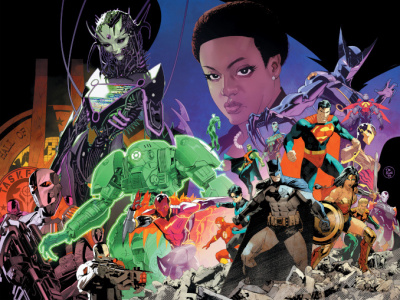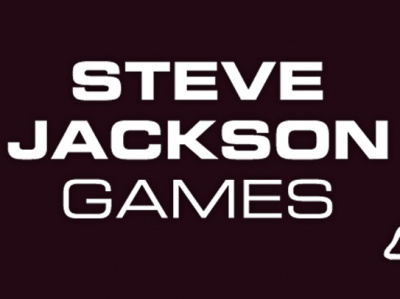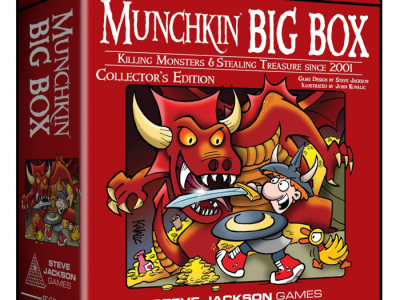 Fantasy Flight Games is one of the most important companies in the hobby games industry. With footprints in board, card, miniature, and roleplaying games, and successful games in each, the company has an unusual span of products and a high rate of success. We recently had a chance for an extended chat with Fantasy Flight Game CEO Christian Petersen on the games market and his company’s place in it. Here is the full version, a small portion of which was recently printed in Internal Correspondence #84.
Fantasy Flight Games is one of the most important companies in the hobby games industry. With footprints in board, card, miniature, and roleplaying games, and successful games in each, the company has an unusual span of products and a high rate of success. We recently had a chance for an extended chat with Fantasy Flight Game CEO Christian Petersen on the games market and his company’s place in it. Here is the full version, a small portion of which was recently printed in Internal Correspondence #84. In Part 2, we talk about keeping games in stock, FFG’s LCGs, Star Wars, and 2014. In Part 1, we talked about the history of the company, the state of the market, and Fantasy Flight’s board games.
As we interview retailers and distributors about your games, there seems to be a pattern where a game will go out of stock, demand will build up, and then you’ll bring it back a couple of months later and ship additional product. Is that a strategy of yours to let them go out of stock to build demand and then bring them back, so you can get faster sales on the reprints?
Well, I don’t think it’s necessarily a strategy of ours. Obviously one of the biggest challenges that any kind of publisher has is to manage the right balance between inventory and sales. The thing that is difficult for us is that we manufacture most of our games overseas and we have fairly long lead times. I would say our restock lead time is typically four to five months. So we tend to bring in our games in fairly large quantities and we tend to gauge how these games do relatively carefully, but we have been fortunate enough that some games just take off much faster than certainly we, or any of the initial stocking on the retail side, would have expected.
So we do have games that from time to time will go out of stock. When we have a game go out of stock, we of course believe the actual marketplace itself should have a two to three month supply. Of course, some retailers will have run out of stock, particularly if they stock very narrowly, but we believe in a three tier system of having a buffer of three or four months of stock, and then we try to restock as soon as we can.
But we have a large library of products. We bring in our stuff in very decent amounts, and we will occasionally go out of stock on products for a couple of months. I think it has more to do with the natural flow of things rather than a predetermined actual strategy. Does that make sense?
Then the question that follows is, if it’s not intentional, why does it happen so often?
The way we gauge our inventories (because, of course, we have to be careful of what kind of investments we put in inventories) is that we gauge demand, and then we gauge what we need to do to properly supply the marketplace. With our line of products and with the number of products that go in and out, I think it’s just natural that there will be, at any one time, a number of products that will be out and then come back. I don’t think it’s something that is particularly problematic.
So you don’t think that it hurts sales and that the demand goes away, that the demand is still there when it comes back in stock?
There is that. I think it’s very important that we have a very good, serious partnership when it comes to our distribution and in our retail chain. Just because we go out of stock doesn’t necessarily mean that the marketplace is out of stock, right?
We do rely on our distributors and retailers to have some months worth of supply so we can gauge when we should bring something back in stock. But certainly, these things have to be made in large bulk, they take a long time to make, so we have to make our investments quite a bit ahead of time, and reprints take four or five months. So if there are spikes in demand, or there is less in the marketplace than maybe there should be then there will be periods where stuff is out of stock.
We often hear this, but keep in mind the number of active titles we have, so it is something that may be seen as more of a problem than it actually is on a mathematical basis. Certainly I understand some of the emotions that can run when you get that one game that they have particular demand for, and we, of course, are out.
There are other examples where we simply cannot make enough and I think specifically when it comes to a game like X-Wing, which goes out of stock regularly, the factories we have working on that game simply are working on them as fast as they can.
We had to make a very specific choice: do we want to limit the amount of supply we put out there or do we want to reduce the quality of the product over the short term? And we decided to keep the product quality as high as we could, and unfortunately that leaves some demand in the marketplace. We have worked really hard the last year and a half to expand our factory capacity to output more, but there may be times where we’re literally making things as fast as we can , whether that’s tool capacity or simply factory capacity to do more, particularly with painted product, to do accurate and nice paint jobs on these things.
How many games do you have in your catalog?
I believe the number of active SKUs that we carry right now across all of the different lines is somewhere in the range of 800 to 900.
What was your annual output in terms of new products in 2013, and what do you expect in 2014?
In terms of new product, we released somewhere around 220 new SKUs last year, we expect that to be around 260 new SKUs this year. In terms of actual productions that we hit every year, we just had a conservative estimate that we’ll start about 1,200 different productions in 2015. We actually start our factory up on a new production run five times a day so our factories are quite, quite active.
So once again, the notion that we print sparsely is maybe overstated, but that is certainly the challenge of keeping everything in stock at all time. It can be something of a challenge for us. But I hope you can also understand it is something that we have to treat very carefully.
We wanted to ask about your card games, the LCG format. You have a number of licensed and house brand titles that you do in that format. You started working in that format at a time when the collectible card game market was very unfriendly to new launches. It seems to have loosened up a little now. Are you still happy with that LCG format as a way of getting card games out there, or are you thinking about any collectible card games in the future?
We are super thrilled with the LCG format. It is probably the biggest shining star in our overall family of products. We really believe very strongly in the various strengths that format has to offer. I think you have had some articles about that in the past, and [SVP--Communications] Steve [Horvath] is a good evangelist for it.
It is a rapidly growing format; LCGs is our second largest category right now and it may be our biggest in a year or two; we’re very happy with it. We believe it’s a way for people to enjoy this kind of constructed card games and be able to enjoy multiple games; and we believe from a pure business model perspective it’s a fair and awesome model to put out there.
Whether we’ll ever do a collectible game again, we have no plans right now to do one. I can’t say we’ll never do one, but we’ve certainly made the non-collectible, fixed format a staple of ours. I don’t have much insight into where collectibles are right now; we’re certainly happy that Magic is as strong as it is, to keep our industry healthy. I have not seen a lot of new entrants into the game market, except for My Little Pony. I don’t have much visibility into how that’s doing other than the online marketing talk.
Fantasy Flight has had a number of licensed games, and a couple of years ago, you got maybe the granddaddy of them all in Star Wars, which you’re now doing in three different formats (minis, RPGs and LCGs). Can you talk about what it’s like to work on that property? Specifically what’s it like in terms of continuity, and is that changing with all the new plans now that they have for future movies and TV shows and so forth?
What’s it like to work on what you called the ‘granddaddy?’ I’m of the generation that grew up as a kid with Star Wars and the original trilogy, the various Kenner action figures, and so on; it’s really a gratifying thing for me personally to be able to put a lot of creativity and hard work and get some great output out of that category, to make our mark in the Star Wars universe a little bit.
We’re all excited, gratified and honored to be doing it.
In terms of continuity, we’ve been very happy to work with Lucasfilm; frankly they are a great licensor (and I don’t say that because I have to). In terms of the most recent changes that they’ve been talking about, they have yet to really hit any of the stuff that we’re doing, so I can’t speak to what kind of changes that it’s going to make. It’s my understanding that it’s not going to be anything that is as dramatic and as retcon-heavy as many may think. But it is something that we’re still studying. In particular, we’ve created a lot of content and written material for the role playing games, so that’s the department that’s most interested in seeing what’s going to go on there.
One of the things we were interested in was that the RPG is set in the Outer Rim, and now this new animated show, Star Wars Rebels, is going to be set there. That seemed interesting that they were exploring that part of the universe.
Yes. We have not been made aware that there’s anything that has been a problem with our Edge of the Empire roleplaying game. That is something we actually worked with them on very, very recently. We think that is still very much valid. But like I said, we don’t really know where they’re going with the forward-looking continuity until they start landing on some of their plans, and they’re ready to start talking about some of those storylines and decisions that they’re making vis-a-vis the movies.
We’re all waiting anxiously to find out what they’re going to be doing there.
What are you most excited about for 2014 at Fantasy Flight?
The problem that I have for 2014 is that we aren’t ready to announce them yet. All I can say is 2014 is going to be my favorite year of all our Star Wars content that we’ve put out; and there’s some new and exciting stuff in that category coming. I hope that will be enough for you.
Do you expect an up year in 2014? What do you see in terms of the overall market for 2014?
In some ways, 2013 was a very careful year for us. With a few exceptions, our teams did not work on a large range of new major releases. We have some major ones we’ve been working on for a while, but we have spent a great deal of our energy, and a large percentage of our teams working all through 2013 and into 2014, on a series of brand new games. So what you’ll see coming out in 2014 from FFG is a much more significant impact on new games and new lines than those that we had in 2013. Specifically, you’ll see some very exciting momentum behind what we’re doing with X-Wing.
We expect 2014 to be an up year for us, and I say with crossed fingers that we have been so fortunate in the market and with our fans pretty much nonstop for the last 10 years, so I hope that will continue.
Click here to go back to Part 1.







